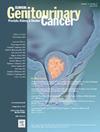Impact of Muscle Depletion on Prognosis in Patients Undergoing Radical Cystectomy
IF 2.7
3区 医学
Q3 ONCOLOGY
引用次数: 0
Abstract
Purpose
To evaluate the prognostic impact of preoperative muscle depletion (including sarcopenia and myosteatosis) in patients with bladder cancer (BCa) after radical cystectomy (RC).
Methods
We retrospectively reviewed 185 patients undergoing RC for urothelial carcinoma. We used the computed tomography images at the L3 level of patients to get the skeletal muscle index (SMI) and skeletal muscle density (SMD). Sarcopenia is defined by the SMI while myosteatosis is defined by SMD. We used univariate Cox regression analysis to identify risk factors and included these risk factors in a multivariate Cox regression analysis to calculate the hazard ratio (HR) and 95% confidence interval (95% CI).
Results
In the univariate Cox analysis, sarcopenia (P < .001) and myosteatosis (P = .017) were both associated with poorer overall survival (OS). Meanwhile, sarcopenia (P < .001) and myosteatosis (P = .019) were both associated with poorer progression-free survival (PFS). In the multivariate Cox analysis, sarcopenia was identified as an independent risk factor for both OS (P = .018) and PFS (P = .005), whereas myosteatosis was not an independent risk factor for OS (P = .225) or PFS (P = .104).
Conclusions
Preoperative muscle depletion (including sarcopenia and myosteatosis) significantly correlates with poor prognosis of patients undergoing RC. Sarcopenia is an in dependent risk factor for 5-year OS and PFS. Our nomogram models demonstrated good predictive accuracy. Preoperative identification of muscle depletion and tailored interventions (exercise and nutrition) may improve postoperative outcomes.
肌肉消耗对根治性膀胱切除术患者预后的影响
目的探讨膀胱癌(BCa)根治性膀胱切除术(RC)后术前肌肉消耗(包括肌肉减少症和肌骨化症)对预后的影响。方法回顾性分析185例尿路上皮癌行膀胱切除术的患者。我们使用患者L3层的计算机断层图像获得骨骼肌指数(SMI)和骨骼肌密度(SMD)。肌少症由SMI定义,而肌骨化症由SMD定义。我们使用单因素Cox回归分析确定危险因素,并将这些危险因素纳入多因素Cox回归分析,计算危险比(HR)和95%置信区间(95% CI)。结果在单因素Cox分析中,肌肉减少症(P <;.001)和肌骨化病(P = .017)均与较差的总生存期(OS)相关。同时,肌肉减少症(P <;.001)和肌肥大症(P = .019)均与较差的无进展生存期(PFS)相关。在多变量Cox分析中,肌肉减少症被确定为OS (P = 0.018)和PFS (P = 0.005)的独立危险因素,而肌骨化症不是OS (P = 0.225)或PFS (P = 0.104)的独立危险因素。结论术后肌肉耗竭(包括肌肉减少症和肌骨化症)与RC患者预后不良有显著相关性。肌肉减少症是5年OS和PFS的依赖危险因素。我们的模态图模型显示出良好的预测准确性。术前确定肌肉消耗和量身定制的干预措施(运动和营养)可能改善术后结果。
本文章由计算机程序翻译,如有差异,请以英文原文为准。
求助全文
约1分钟内获得全文
求助全文
来源期刊

Clinical genitourinary cancer
医学-泌尿学与肾脏学
CiteScore
5.20
自引率
6.20%
发文量
201
审稿时长
54 days
期刊介绍:
Clinical Genitourinary Cancer is a peer-reviewed journal that publishes original articles describing various aspects of clinical and translational research in genitourinary cancers. Clinical Genitourinary Cancer is devoted to articles on detection, diagnosis, prevention, and treatment of genitourinary cancers. The main emphasis is on recent scientific developments in all areas related to genitourinary malignancies. Specific areas of interest include clinical research and mechanistic approaches; drug sensitivity and resistance; gene and antisense therapy; pathology, markers, and prognostic indicators; chemoprevention strategies; multimodality therapy; and integration of various approaches.
 求助内容:
求助内容: 应助结果提醒方式:
应助结果提醒方式:


